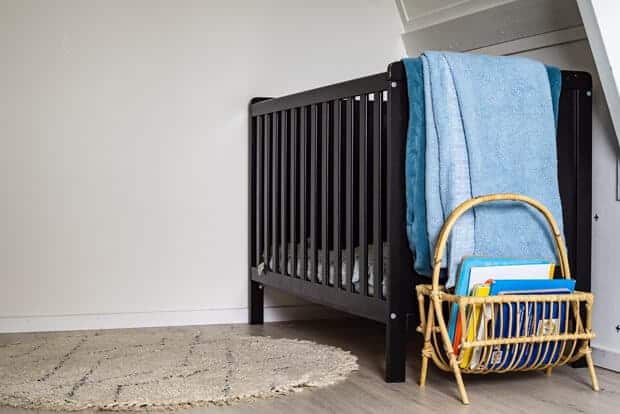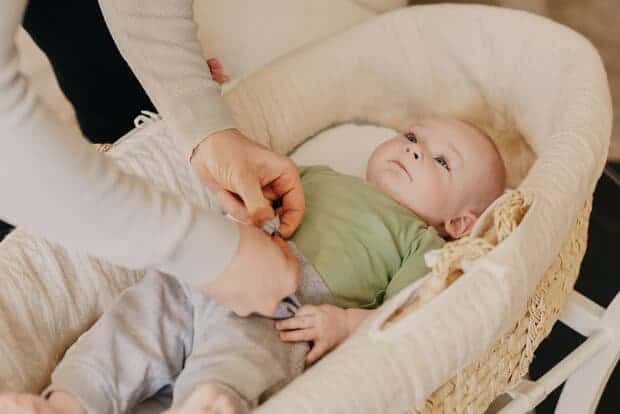Imagine the moment when you hear your baby’s first cry. You’ve given birth to your miracle, and now they’re in your arms – you’re in awe. Baby is tiny, delicate, and needs your loving care. One of the best things you can do for them is keep them safe by making sure they are properly elevated in their own crib with a lowered mattress.

Why Lower the Crib Mattress Height?
There are a number of reasons as to why lowering the mattress height is beneficial to an infant. Studies have shown that over 50% of babies will sleep better and longer if the mattress height is lowered. One study found that lowering the mattress by less than an inch had a profound effect on infant’s sleep and wakefulness. Both mothers and fathers reported more satisfaction and happiness with their child because their baby was sleeping better, longer and more often. When babies sleep better, parents sleep better.
Factors to Consider when Deciding To Lower the Crib Mattress
For many parents, the question of when to lower the crib mattress may seem like a trivial one. They might be wondering why a parent would need to know this before their baby is born. However, there are a number of factors that parents should consider before deciding whether or not they should lower their crib’s mattress.
How Tall Is the Baby
It is important to keep in mind that the height of the baby will affect when you should lower the crib mattress. Babies, who are at a young age, have a tendency of sleeping on their backs, which can put unnecessary strain on their neck and spine. Conversely, once they reach toddlerhood they may start to sleep more on their stomachs or sides, making it imperative to raise the crib mattress to avoid any physical injuries.

Baby Has Outgrown Their Crib
Baby’s crib is often one of the baby’s favorite places to sleep, but there are many parents that wonder just when they should lower the mattress. The American Academy of Pediatrics suggests lowering the mattress once baby can sit up unassisted, has outgrown the amount of space in the crib, or has started showing signs of becoming uncomfortable while sleeping. There are some cases where it might be time to transition baby to a toddler bed instead, such as when they start climbing out on their own.
Age of the Baby
Babies start to grow teeth and can push themselves up to a standing position as early as 3 months old, making it difficult for them to sleep comfortably in a flat crib. Given that parents want their babies to be comfortable and safe, they may lower the crib mattress when their baby is six months old. Lowering the mattress will make the crib more stable and allow the baby to sleep soundly without worry of rolling out or getting stuck.
What Age Do You Transition from Crib to Toddler Bed?
Ever wonder what age you should transition from a crib to a toddler bed? Well, the experts say that toddlers should ideally be transitioning out of their cribs at 18-24 months old.
In order for a child to get the most restful sleep, it is crucial that they have the appropriate amount of space. While it is possible for a child to move from crib to toddler bed without going through a transitional stage, this would result in an overtired and cranky toddler who has trouble falling asleep and staying asleep.
When your child is able to climb out of the crib on their own, it’s time to transition them to a toddler bed. Take note of what age your child was potty trained as well, this will also help you determine when the right time is. Another important thing to remember is how high off the ground your child can reach.

How to Choose a Crib
It’s an exciting time for parents-to-be as they plan for their baby’s arrival, but it can also be a stressful time. One of the most important pieces of furniture you will need is a crib to lay your child down for sleep. There are many aspects to consider when choosing a crib.
Size
The first thing to do is decide what size you need, according to your child. The crib will need to be big enough to fit all your baby’s clothes, blankets, and accessories. The crib should be big enough to allow your child to lie down, move around, and kick out, so it’s important to be sure to double check the measurements.
Materials
The most important aspect of choosing a crib is the material. You can choose from wood, metal, plastic, or a combination of materials. Some kids prefer the plastic crib, while others prefer wood. Some parents like the metal cribs because they’re lightweight, easy to move, and easy to clean. Some parents like the wooden cribs because of the natural look and feel of the wood, but metal cribs hold up better and are easier to care for.
Safety Features
The safety of your child is one of the most important factors you should consider when choosing a crib. The CPSC (Consumer Product Safety Commission) recommends that all cribs include a top bar to prevent your child from falling out of the crib. Additionally, some cribs have a guardrails to prevent your child from falling out of the crib. Some parents install a guardrail above the crib only and some install a guardrail above and below the crib.

Crib vs Bassinet
Cribs and bassinets are both safe, but they can be used for different stages of development. Cribs provide a more natural sleep environment where the baby is surrounded by a mattress and bedding. The crib also provides support and safety features such as bars and high-quality hardware which protect the baby from falling out. A bassinet is often used in the early months as it provides better sleep for babies who need to nap during the day.
Pros and Cons of a Crib
Kids need a safe place to sleep and a crib can provide a safe, comfortable place for a child to sleep. Cribs are also easy to move from one room to the next, making it possible for parents to rotate their children’s bedrooms. There have been studies that show that infants who sleep in cribs have less risk of Sudden Infant Death Syndrome (SIDS) than those who sleep on their stomach or side.
However, the drawbacks of using a crib is the risk of injury or death that can occur by suffocation or while lying on baby’s back. Another major drawback of using a crib is that it will limit the baby’s mobility and exploration. For instance, by not being able to get out of bed, the baby will never be able to learn how to crawl. A third disadvantage of using a crib is that it doesn’t allow for interaction with parents or other caregivers.
Pros and Cons of a Bassinet
In the first few days of a newborn’s life, he or she will spend most of their time sleeping. In order to provide a safe space for your little one to sleep, a bassinet is a great choice! Bassinets are also more convenient for parents during nighttime feedings because the baby can be moved from room to room without waking up. Bassinets are typically smaller than traditional cribs and this makes them easy to transport around the house.

Bassinets are often sought out for their aesthetic appeal, yet they can sometimes be at the root of sleep deprivation for parents. A bassinet is typically very lightweight and has a wider base than an adult-sized crib which can make it difficult for babies to lie flat on their backs when in the bed. This can lead to colic or reflux, as well as ear infections especially in colder weather when humidity is lower.
Final Thoughts
In conclusion, lowering your baby’s crib mattress will help to prevent the risk of sudden infant death syndrome. This will also make it easier to pick up and move around the crib because you will not have to bend down as far. In addition, lowering the crib mattress is a great way to reduce the risk for other injuries such as concussions, bruises, and scrapes from bumping their head from time to time.









